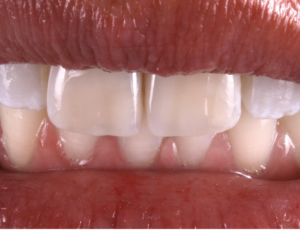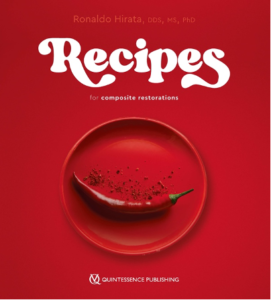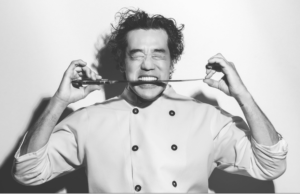It’s an open secret that the restorative cases featured in most conferences and lecture halls are often aspirational; they are meant to impress, but not enough information is shared to make the results achievable by most clinicians. Ronaldo Hirata has been on the main podium enough to understand how this works and how to showcase clinical masterpieces to best effect. And what is his response? He has been bucking the trend and making the case that true excellence comes not from complicated, flashy techniques but from mastering the fundamentals.

In his latest book, Recipes for Composite Restorations, Prof Hirata takes his inspiration directly from the culinary world. The best chefs know that by breaking down their recipes and teaching their techniques to the world, they can truly share their vision and elevate the profession. They want to help as many cooks as possible improve their craft. With this same logic and passion, Prof Hirata has put together 26 essential “recipes” that represent clinical situations central to restorative work. He uses the familiar format of a cookbook and makes certain to document every stage. Each recipe includes a list of ingredients and instruments, the approximate timing for each phase, and tips and tricks to ensure the recipe is a success. For many recipes, he also includes video clips to highlight a particular technique. It’s great. Everything about this book is straightforward and well thought out. As expected, beautiful results are highlighted in every recipe, but we can track exactly how the author got there, and the steps and techniques are feasible and reproducible.

The tips featured throughout are real gems and are as simple as a recommendation for intraoral retractors or which endodontic tools can be used in restorative work, to how to characterize milled composite onlays or even an innovative Lego technique used with semi-direct restorations. Each one is a real trick of the trade that Prof Hirata has come up with or picked up from other colleagues. These tips show that innovation can be both playful and eminently practical.

Taken together, all the elements work, and his cookbook does exactly what it sets out to do, which is to empower clinicians to improve their restorative work and achieve more. There is an implicit promise that these are the recipes that can unlock further risks and excellence in restorative work. If you can scale these summits, you can climb even higher. It’s a heady promise, and I hope it also means that there will be more cookbooks from Prof Hirata in the years to come.
At the end of the day, the real success of this book is its primary message: “Keep it simple. Master the basics.”
Taste a sample of Prof Hirata’s book here.
 Recipes for Composite Restorations
Recipes for Composite Restorations
Ronaldo Hirata
Although many dental manuals have been called “cookbooks,” none has ever embraced the style so fully as this new book. In its pages, the practitioner is fully reimagined as a master chef, and 26 esthetic restorative protocols are presented as gourmet recipes, ready to be learned and savored. The purpose of this book is to encourage true mastery of the fundamentals while avoiding the most common pitfalls. Dr Hirata demonstrates how to make the most of composite materials by focusing on the details and techniques that can really improve the final results. In restorative dentistry, the key is to use the right materials with the best technique. However, that is not enough. Any chef knows that once you have learned the fundamentals, your best work must also reflect your personal character, and the same goes for the work of restorative dentists. By focusing on the skillful use of the right ingredients and tools, this tour de force will teach you how to take the heat and take your restorative protocols to the next level.
 Ronaldo Hirata, DDS, MS, PhD, finished his 4-year DDS course at the Federal University of Parana in Curitiba, Brazil, in 1995. After completing his degree, he undertook a 2-year operative dentistry specialty at the same university and began lecturing internationally, with a focus on esthetic dentistry. Dr Hirata has now lectured in more than 40 countries and maintains a private practice limited to esthetic dentistry in Curitiba. To improve his scientific knowledge, Dr Hirata finished a master’s degree in dental materials in 2003 at the Catholic University of Rio Grande do Sul, with a research thesis working with glass and polyethylene fibers to improve mechanical properties of composites. His PhD in restorative dentistry at the State University of Rio de Janeiro was completed in 2009, with research focusing on the transmittance, reflectance, and fluorescence of composite resins. In 2012, Dr Hirata undertook a postdoctorate at New York University (NYU) working with plasma application on dentin surfaces and bonding strength analysis. Now, he is Assistant Professor in the Department of Biomaterials at NYU with a secondary appointment in the Department of Cariology. Dr Hirata has published more than 100 papers in English, Portuguese, and Spanish, and his previous books (TIPS, Artes Medicas, 2014; Shortcuts, Quintessence, 2017) were both published in three languages.
Ronaldo Hirata, DDS, MS, PhD, finished his 4-year DDS course at the Federal University of Parana in Curitiba, Brazil, in 1995. After completing his degree, he undertook a 2-year operative dentistry specialty at the same university and began lecturing internationally, with a focus on esthetic dentistry. Dr Hirata has now lectured in more than 40 countries and maintains a private practice limited to esthetic dentistry in Curitiba. To improve his scientific knowledge, Dr Hirata finished a master’s degree in dental materials in 2003 at the Catholic University of Rio Grande do Sul, with a research thesis working with glass and polyethylene fibers to improve mechanical properties of composites. His PhD in restorative dentistry at the State University of Rio de Janeiro was completed in 2009, with research focusing on the transmittance, reflectance, and fluorescence of composite resins. In 2012, Dr Hirata undertook a postdoctorate at New York University (NYU) working with plasma application on dentin surfaces and bonding strength analysis. Now, he is Assistant Professor in the Department of Biomaterials at NYU with a secondary appointment in the Department of Cariology. Dr Hirata has published more than 100 papers in English, Portuguese, and Spanish, and his previous books (TIPS, Artes Medicas, 2014; Shortcuts, Quintessence, 2017) were both published in three languages.
